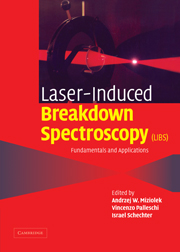Book contents
- Frontmatter
- Contents
- List of contributors
- Preface
- 1 History and fundamentals of LIBS
- 2 Plasma morphology
- 3 From sample to signal in laser-induced breakdown spectroscopy: a complex route to quantitative analysis
- 4 Laser-induced breakdown in gases: experiments and simulation
- 5 Analysis of aerosols by LIBS
- 6 Chemical imaging of surfaces using LIBS
- 7 Biomedical applications of LIBS
- 8 LIBS for the analysis of pharmaceutical materials
- 9 Cultural heritage applications of LIBS
- 10 Civilian and military environmental contamination studies using LIBS
- 11 Industrial applications of LIBS
- 12 Resonance-enhanced LIBS
- 13 Short-pulse LIBS: fundamentals and applications
- 14 High-speed, high-resolution LIBS using diode-pumped solid-state lasers
- 15 Laser-induced breakdown spectroscopy using sequential laser pulses
- 16 Micro LIBS technique
- 17 New spectral detectors for LIBS
- 18 Spark-induced breakdown spectroscopy: a description of an electrically generated LIBS-like process for elemental analysis of airborne particulates and solid samples
- Index
- References
14 - High-speed, high-resolution LIBS using diode-pumped solid-state lasers
Published online by Cambridge University Press: 08 August 2009
- Frontmatter
- Contents
- List of contributors
- Preface
- 1 History and fundamentals of LIBS
- 2 Plasma morphology
- 3 From sample to signal in laser-induced breakdown spectroscopy: a complex route to quantitative analysis
- 4 Laser-induced breakdown in gases: experiments and simulation
- 5 Analysis of aerosols by LIBS
- 6 Chemical imaging of surfaces using LIBS
- 7 Biomedical applications of LIBS
- 8 LIBS for the analysis of pharmaceutical materials
- 9 Cultural heritage applications of LIBS
- 10 Civilian and military environmental contamination studies using LIBS
- 11 Industrial applications of LIBS
- 12 Resonance-enhanced LIBS
- 13 Short-pulse LIBS: fundamentals and applications
- 14 High-speed, high-resolution LIBS using diode-pumped solid-state lasers
- 15 Laser-induced breakdown spectroscopy using sequential laser pulses
- 16 Micro LIBS technique
- 17 New spectral detectors for LIBS
- 18 Spark-induced breakdown spectroscopy: a description of an electrically generated LIBS-like process for elemental analysis of airborne particulates and solid samples
- Index
- References
Summary
Introduction
Most of the investigations and applications of LIBS use laser sources operating at repetition frequencies in the range of 10–20 Hz, yielding laser pulse energies of typically 50–300 mJ. This is a consequence of the broad commercial availability of Q-switched flashlamp-pumped solid-state lasers. The most important laser type is the Nd:YAG laser with an emission wavelength in the near infrared at 1064 nm. Such lasers are reliable radiation sources for a variety of research topics and industrial applications. The dominant industrial application field is laser material processing, for example marking, drilling, cutting and cleaning. The first industrial applications of LIBS have also been realized on the basis of flashlamp-pumped Nd:YAG lasers [1–4].
The prevailing task for LIBS with repetition frequencies between 10 and 20 Hz is bulk analysis of materials. A few papers deal with spatially resolved measurements [5–8]. A relative motion between the focused laser beam and the sample enables a scanning across the surface. The spectral information gained is linked to the location of irradiation of the laser pulse onto the sample surface. The result is presented, for example, as an element line intensity of the laser-induced plasma versus one or two spatial coordinates. The latter situation yields maps of element-specific intensities of a sample surface. However, a mapping with a step size of 20 μm by scanning of an area of 1 cm2 of a sample requires 250 000 single measurements.
- Type
- Chapter
- Information
- Laser Induced Breakdown Spectroscopy , pp. 490 - 515Publisher: Cambridge University PressPrint publication year: 2006



